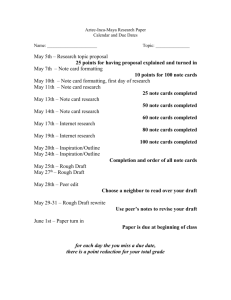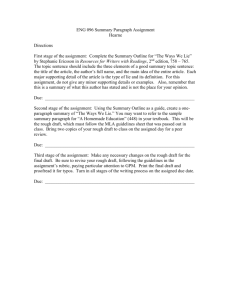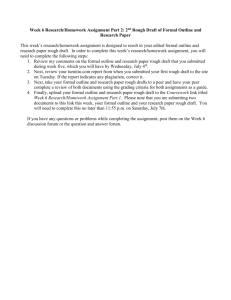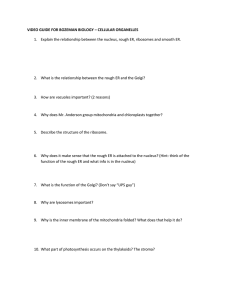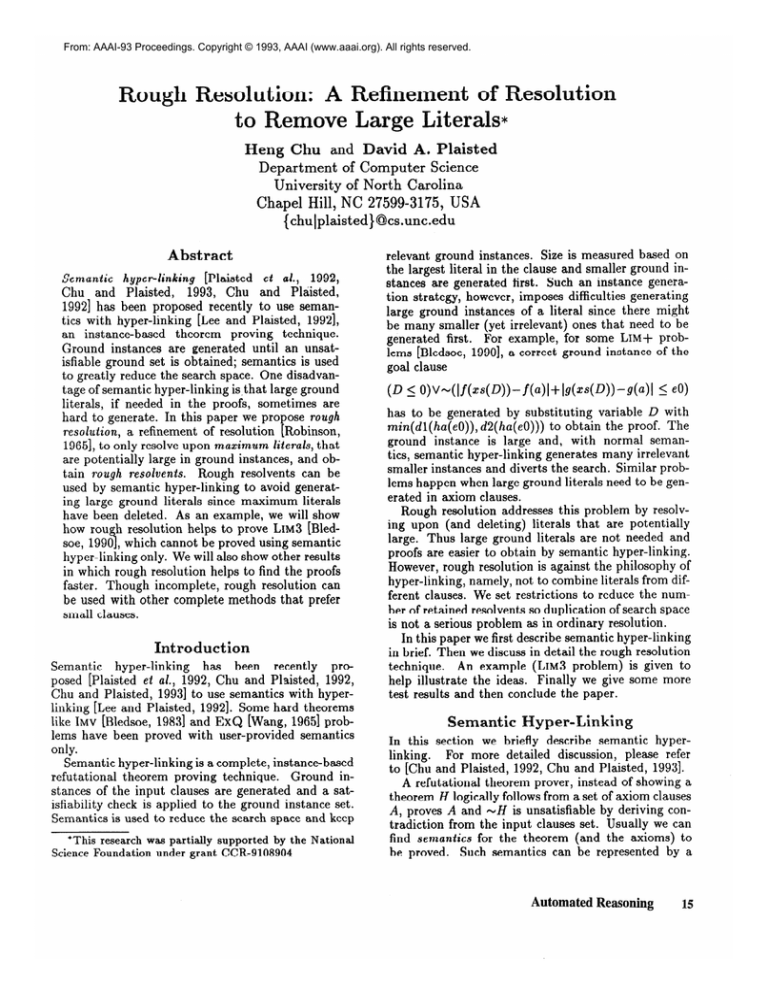
From: AAAI-93 Proceedings. Copyright © 1993, AAAI (www.aaai.org). All rights reserved.
Rough Resolution: A Refinement of Resolution
avid A, Plaistecl
Heng Chu and
Department of Computer Science
University of North Carolina
Chapel Hill, NC 27599-3175,
USA
{ chulplaisted}@cs.unc.edu
Abstract
Semantic
hyper-linking
[Plaisted et al., 1992,
Chu and Plaisted,
1993, Chu and Plaisted,
19921 has been proposed recently to use semantics with hyper-linking [Lee and Plaisted, 19921,
an instance-based
theorem proving technique.
Ground instances are generated until an unsatisfiable ground set is obtained; semantics is used
to greatly reduce the search space. One disadvantage of semantic hyper-linking is,that large ground
literals, if needed in the proofs, sometimes are
hard to generate. In this paper we propose rough
resolution, a refinement of resolution [Robinson,
19651, to only resolve upon maximum liter&, that
are potentially large in ground instances, and obtain rough resoluents.
Rough resolvents can be
used by semantic hyper-linking to avoid generating large ground literals since maximum literals
have been deleted. As an example, we will show
how rou h resolution helps to prove bM3 [Bledsoe, 19909 , which cannot be proved using semantic
hyper-linking only. We will also show other results
in which rough resolution helps to find the proofs
faster. Though incomplete, rough resolution can
be used with other complete methods that prefer
small clauses.
Introduction
Semantic
hyper-linking
has been recently
proposed [Plaisted et al., 1992, Chu and Plsisted, 1992,
Chu and Plaisted, 19931 to use semantics with hyperlinking [Lee and Plaisted, 19921. Some hard theorems
like IMV [Bledsoe, 19831 and ExQ [Wang, 19651 problems have been proved with user-provided semantics
only.
Semantic hyper-linking is a complete, instance-based
refutational theorem proving technique.
Ground instances of the input clauses are generated and a satisfiability check is applied to the ground instance set.
Semantics is used to reduce the search space and keep
*This research was partially supported by the National
Science Foundation under grant CCR-9108904
relevant ground instances. Size is measured based on
the largest literal in the clause and smaller ground instances are generated first. Such an instance generation strategy, however, imposes difficulties generating
large ground instances of a literal since there might
be many smaller (yet irrelevant) ones that need to be
generated first. For example, for some LIMi- problems [Bledsoe, 19901, a correct ground instance of the
goal clause
P
-< o)v-(lf(~s(~))-f(~>l+Ig(~s(D))-g(~)l
L 4
has to be generated by substituting variable D with
min(dl(ha(eO)), d2(ha(eO))) to obtain the proof. The
ground instance is large and, with normal semantics, semantic hyper-linking generates many irrelevant
smaller instances and diverts the search. Similar problems happen when large ground literals need to be generated in axiom clauses.
Rough resolution addresses this problem by resolving upon (and deleting) literals that are potentially
large. Thus large ground literals are not needed and
proofs are easier to obtain by semantic hyper-linking.
However, rough resolution is against the philosophy of
hyper-linking, namely, not to combine literals from different clauses. We set restrictions to reduce the number of retained resolvents so duplication of search space
is not a serious problem as in ordinary resolution.
In this paper we first describe semantic hyper-linking
in brief. Then we discuss in detail the rough resolution
technique.
An example (LIM3 problem) is given to
help illustrate the ideas. Finally we give some more
test results and then conclude the paper.
yper-linking
In this section we briefly describe semantic hyperFor more detailed discussion, please refer
linking.
to [Chu and Plaisted, 1992, Chu and Plaisted, 19931.
A refutational theorem prover, instead of showing a
theorem H logically follows from a set of axiom clauses
A, proves A and -H is unsatisfiable by deriving contradiction from the input clauses set. Usually we can
find semantics for the theorem (and the axioms) to
be proved. S UCh semantics can be represented by a
Automated Reasoning
15
structure which contains a domain of the objects and
interpretations
for constants, functions and predicates.
A structure can be viewed as a (possibly infinite) set of
all ground literals true in the semantics. A structure 1
is decidable if for a first-order formula F it is decidable
whether F is satisfied by I.
According to Herbrand theorem, in the input clauses
for a refutational
theorem prover, there must be
ground instances of some clauses (usually the negation of the theorem) that are false in the semantics;
otherwise the input clauses are satisfiable. In general,
no matter what semantics is chosen, such false ground
instances exist for the input set. This observation is
the base of semantic hyper-linking.
The idea of semantic hyper-linking is this: Initially a
decidable input structure is given by the user, then the
prover systematically
changes the structure (semantics) by generating ground instances of input clauses
that are false in the structure.
We have a set U of
ground instances, initially empty. Ground instances
that are false in the current structure, are generated.
User-provided semantics is used to help generate the
new ground instances.
These ground instances are
added to U. Then the structure is changed, if possible,
to satisfy U. This procedure is repeated with the new
structure until U is unsatisfiable.
For details, please
see [Plaisted et aZ., 1992, Chu and Plaisted, 1992,
Chu and Plaisted, 19931.
Semantic hyper-linking has been shown to have
great potential.
Hard theorems like IMV (the intermediate value theorem in analysis) [Bledsoe, 1983,
Ballantyne and Bledsoe, 19821 and ExQ (three examples from quantification theory) [Wang, 19651 are
proved with the user-provided semantics only. No
other human control is needed.
However, if large
ground literals are needed for the proof, they often
are difficult to generate because of the way the ground
instances are generated (which is basically an enumeration of the Herbrand base). Many small irrelevant
ground literals need to be generated before large ones
are generated. This generates a lot of useless smaller
ground instances to complicate the proof search and
makes many theorems unable to be proved. Rough
resolution is designed to address this problem.
Rough
Resolution
The basic idea of rough resolution is simple: we only
resolve on those literals that are potentially large in
ground instances.
Those literals- resolved ‘upon are
deleted in the resolvents and their ground instances
need not be generated.
If such larffe ground literals are used in the proof, rough resoi&n
can avoid
generating them and help semantic hyper-linking find
the proof faster. For example, consider the following
clauses (x, y and z are variables):
Cl = { v(2, Y, f(z)), +, 2) 1
62 = { g(f(4, g(y), 4 -f(5
Y) 1
If the following two ground instances are needed
16
Chu
in the
proof
which
needs
no other
S(fWl s@(b)), f(4):
G = i -s(fW,
!7@(w~ f(c)),
Ci = ( g( f (a), g(h(b)),
f(c)),
instances
d(c, f(4)
-f
of
1
(a, h(b)) }
We can resolve Cl and C2 upon the first literals and
get
c = { d(%, f (41,
Then,
stance
-f (2, Y) 1
instead of C; and Ci, a smaller ground in-
c’ = { d(c, f(a)),
-f 6% h(b)) 1
can be used in the proof and avoids the use of larger
g(f(a), g(h(b)), f(c)) which might be difficult to generate by semantic hyper-linking.
Maximum Eiterds
Binary resolution on two clauses Cl and C2 chooses
one literal L in Cl and one literal M in C2 such that
LO = -MO, where 0 is a most general unifier of L and
NM. A resolvent R=(Cl - L)B U (C2 - M)B is generated. R is smooth if LOU is never larger than any literal
in Ra for any a; R is rough if for some 6, L&T is larger
than any literal in Ra. Smooth resolvents are not kept
because they only remove small literals (the “smooth”
parts of clauses); large literals (the “rough” parts of
clauses) remain as a difficulty. Thus we are particularly interested in rough resolvents because they might
remove large literals needed for the proof. Rough resolvents can be obtained by resolving upon maximum
literals.
Definition
1 A literal L in a clause C is an absolute
literal if, for all u, the size of Lu is larger
than or equal to that of any literal in Cu; L is a likely
maximum
literal if for some u, Lo is larger than or
maximum
equal to any literal in Cu.
A clause can only have one of those two kinds of maximum literals. For example, in clause
( d(v, k(w, u)), -d(u, u), -d(v, w) 1
where ‘1~,u and w are variables, d(v, k(w, u)) is the only
absolute maximum literal; in clause
{ 4%dw,a --d(fb, 4,4,4% 4 1
d(u, q(w, v)) and 4( f (u, v), 20) are absolute max-
both
imum literals; clause
1 d(u, v), -d(v, u> }
has two absolute maximum literals; in clause
j 4% wh-d(u, 4, -4% 4 1
all three literals are likely maximum literals.
efinition 2 A rough resolution step involves simultaneously resolving upon maximum literals L1, . . . , L,
of a clause C (called nuclei) with some absolute maximum literals in other clauses Cl,. . . , C, (called electrons).
A rough resolvent is obtained from a rough
resolution step.
Nuclei can have absolute or likely maximum literals;
electrons can only have absolute maximum literals.
Absolute maximum literals in a nucleus are all resolved
upon at the same time in one single rough resolution
step. This is based on the observation that absolute
maximum literals should be eventually all removed
since they are always the largest in any instances, and
intermediate resolvents might not be saved due to nonnegative growths (to be discussed in next section).
Resolving on likely maximum literals in a clause is
difficult to handle because it might not delete large
literals and, at the same time, could generate too many
useless resolvents. For example, the transitivity axiom
contains three likely maximum literals and often generates too many clauses during a resolution proof. Their
role is obscure in rough resolution. We have used two
strategies to do rough resolution on likely maximum
literals.
The first is to apply the following heuristics to simultaneously resolve on more than one likely maximum literal: if there are two likely maximum literals
in a clause, we resolve upon them one at a time; if
there are more than two likely maximum literals, we
also resolve upon each possible pair of two of them at
the same time. This is based on the observation that
usually only few likely maximum literals will become
the largest in the ground instances.
Another important strategy is to require that any
likely maximum literal resolved upon should still be a
likely (or absolute) maximum literal after the proper
substitution is applied. Otherwise the resolvent is discarded because it introduces larger literals from those
not resolved upon.
For example, consider the clause
where all literals are likely maximum literals. Suppose
first two literals are resolved with p(z, Q) and ~(a, z)
respectively with substitution 0 = { y + LX}. Such resolution is not allowed since none of p(x, a) and p(a, z)
are maximum literals in C0, and the literal not resolved
upon, p(x, z), becomes an absolute maximum literal in
ce.
Retaining
Resolvents
Rough resolution only resolves upon maximum literals.
Since usually there are not many absolute maximum
literals in a clause, the number of resolvents are greatly
reduced. However there are still too many resolvents
if no further restriction is applied. In this section we
discuss one strategy that we use to retain resolvents
more selectively.
From the rough resolvents, we prefer those smaller
than the parents clauses. Ordering on clauses is needed
here and we use ordering of the multisets of all literal
sizes in a clause.
3 ICI is the multiset of sizes of all literals
in C. Difference ICll- l&l is cl - c2 where cl and c2
are the largest elements (0 if the multiset is empty) in
ICll and l&l respectively after common elements are
deleted.
Definition
For example,
for clause C = { p(x),p(y),
ICI = {3,2,2);
(3,2,2)
and {4}-{5,2)=
-1.
- ($2)
= (2)
-Q(z, Y) },
- {}
= 2
nition 4 Suppose in a rough resolution step, resolvent R is obtained from clauses Cl, . . . , C,. The
growth of R is IRI- maximumof (ICll, l&l, . . ., I&I).
Such multiset idea is only used to compute growth of a
rough resolvent. In other situations the size of a clause
is still the largest literal size.
Growth is a useful measurement to retain resolvents
from resolving upon likely maximum literals.
Intuitively growth indicates the size growth of a rough resolvent relative to the parent clauses before substitution is applied. If growth is negative, the resolvent is
smaller than the largest parents clause and “progress”
has been made to reduce the number of large literals.
On the other hand, if the growth is zero or positive,
the resolvent is of the same length or larger than the
largest parent clause. There is no progress from this
rough resolution step and it is not useful to keep the
resolvent .
The algorithm of rough resolution is described in
Fig. 1. I&solvents of non-negative growth are retained only when there are no resolvents with negative
growth. The procedure repeats until a proof is found.
The resolvents are used in semantic hyper-linking in a
limited way because many resolvents could be generated. Reasonable time bound is set on the use of rough
resolvents in semantic hyper-linking.
The collaboration of rough resolution and semantic
hyper-linking is not explicitly shown in Fig. 1. Basically rough resolution executes for some amount of
time then stops, and new resolvents are used in later
semantic hyper-linking; when executed again, rough
resolution picks up from where it left off and continues.
The rough resolvents with negative growth are always kept; among the rough resolvents with nonnegative growth, only the smallest (in terms of the
largest literal in the resolvent) are saved, if necessary.
This allows the resolvents with non-negative growth to
be used in a controlled manner.
ith restrictions on how rough resolution is applied
(by resolving upon maximum literals simultaneously)
and how resolvents are retained (based on growth),
much less resolvents are retained than those in other
similar resolution strategy. And we have found the algorithm practical and useful when used with semantic
hyper-linking.
Automated Reasoning
17
Algorithm Rough Resolution
begin
loop
for each clause C with absolute maximum literals
Obtain a new rough resolvent R using C as nucleus
if R has a negative growth
list of clause numbers. with nuclei in boxes. For example, @,3,17)
denotes
’ a rough resolution step using
clause 14 as nucleus and clauses 3 and 17 as electrons.
then
save R permanently
as a new clause
else
save R temporarily
until there are no new resolvents with growth < 0
for each clause C having likely maximum literals
loop
Obtain a new rough resolvent R using C as nucleus
if R has negative growth
then
save R permanently as a new clause
else
save R temporarily
until no new rough resolvents can be generated
if in last loop no rough resolvent was generated
with negative growth
The proof:
then
for each smallest temporarily saved rough
resolvent R
save R permanently as a new clause
end
Figure 1: Algorithm:
Rough Resolution
,-Zt(aG),
-WW’),
WW
ha(Z)),
)
24: a,21)
(I -Zt(ab(pZ(f
(xs(D)),
w(f W)), h4W) I
--It(aW(g(x@)), ns(s(a)))),h+O)) Jt(D, 0))
An Example
Bledsoe gave LIM+ problems in [Bledsoe, 19901 as challenge problems for automated theorem provers. Because of the large search space they might generate,
LIM+ problems are difficult for most theorem provers.
However, they are not difficult for St&e
[Hines, 19921
which has built in inequality inference rules for densed
linear ordering.
In this section we will look at the proof of EIM3 using
rough resolution. Intermediate results from semantic
hyper-linking are omitted.
As mentioned in the introduction, the correct ground
instance of the goal clause has to be generated to obtain the proof. However, that ground instance contains
a literal so large that semantic hyper-linking cannot
generate it early enough in the search for the proof. As
a result, the prover got lost even before correct goal instances are generated. Rough resolution helps to delete
large literals by resolving upon them; smaller ground
literals are generated by semantic hyper-linking. It is
interesting to observe that the proof presented here
does not need the term min(dl(ha(eO)), d2(ha(eO)))
which is essential to human proofs.
We only list clauses used in the proof; literals in
boxes are maximum literal8 and only clauses 14 and
15 (from the same transitivity axiom) have likely maximum literals. Each rough resolution step is denoted by
18
Chu
s(D),w(a))), dl(h+W)]p
--It(ab(p@(D), w(a))), d2(ha(eO)))
y
Zt(ha(eO),
4, WA 0))
97: (j-izJ,29,10)
{I-Zt(ab(~Z(xs(D),
rig(a))),
-Zt(D,
dl(ha(eO))),
-Zt(D,
da(ha(eO))),
d2(ha(eO)))
1,
Zt(ha(eO), o), Zt(D, o)}
), w(a))),
dl(ha(eO)))
1,
Zt(ha(eO), o), Zt(D, 0))
139: (j-iEJ,97)
{ 1-Zt(d2(ha(eO)),
dl(ha(eO)))
Zt(ha(eO), o), Zt(da(ha(eO)),
(w+o),
deleted)
0)
1,
o) }
and Zt(d2(ha(eO)),o)
are then
unit
are then
unit
y;,
Zt(ha(eO), o), Zt(dl(ha(eO)),
(Wa(eO),
deleted)
0)
o) }
and Zt(dl(ha(eO)),o)
13 ,139,141)
is obtained and a proof is found.
Y-9
Unit { wZt(ha(eO), o) } is generated by model filtering [Chu and Plaisted, 19931 in semantic hyper-linking.
Or it can be generated by UR resolution from clause
4 and 7. It is then used with clause 5 to genero) }; with clause 6 to generate
ate { wZt(dl(ha(eO)),
{ -Zt(d2(ha(eO)),
o) }.
4:
{ wZt(e0, 0) }
5:
{ Zt(X, o), -Zt(dl(X),
6:
{ Zt(X, o), -Zt(d2(X),
7:
( Zt(X, o), -Zt(ha(X),
o) }
o) }
o) }
None of the above three units can be generated
by rough resolution. This shows the collaboration of
rough resolution with semantic hyper-linking to find
the proof.
We have implemented a prover in Prolog. Experiment
results show that rough resolution indeed improves
the prover and often helps to find proofs faster. Table 1 lists some results (in seconds) that show rough
resolution is in general a useful technique used with
semantic hyper-linking.
AMY is the attaining maximum (or minimum) value theorem in analysis [Bledsoe, 19831; LIMl-3 are the first three LIM+ problems proposed by Bledsoe [Bledsoe, 19901; IMV is
the intermediate value theorem in analysis [Bledsoe,
19831; 11, IPl, Pl and Sl are four problems in implicational propositional calculus [Lukasiewicz, 1948,
Pfenning, 19881; 1~37 is the theorem that Vx E a ring
R+*O=
0 where 0 is the additive identity; SAM’s
lemma is a lemma presented in [Guard et al., 19691;
wosl5 proves the closure property of subgroups; wosl9
is the theorem that subgroups of index 2 are normal;
wos20 is a variant of wosl9; wos2l is a variant of 1~37;
and ExQ problems (including wos3 1) are three examples from quantification theory [Wang, 19651.
LIMl-3 are considered simpler in [Bledsoe, 19901.
Prover STROVE, with built in inference rules for densed
linear ordering, can easily prove all LIM+ problems.
However, few other general-purpose theorem provers
can prove LIMA-3 (especially LIM3). METEOR
[Astrachan and Loveland, 19911 can prove all three by
using special guidance. OTTER [McCune, 19901 and
CLIN [Lee and Plaisted,
19921 could not prove any
LIM+ problem.
Conclusions
Rough resolution is incomplete but it is useful when
used with other complete methods that prefer small
clauses. It helps to focus on removing “large” part
of the proofs. In particular, we have found that semantic hyper-linking and rough resolution conceptually work well together: semantic hyper-linking solves
the “small” and “non-Horn” part of the proof; UR resolution [Chu and Plaisted, 19931 solves the “Horn” part
Problem
AMY
LIMl
LIM2
LIM3
IMV
SAM’s Lemma
wos15
I
with rough
resolution
2127.3
83.0
63.3
534.8
374.5
146.5
282.7
without rough
resolution
-*
49.8
95.5
-
*U n indicates the run is aborted after either running
over 20,000 seconds or using over 30 Megabyte memory
Table 1: Proof results using rough resolution with semantic hyper-linking
of the proof; and rough resolution solves the “large”
part of the proof.
Rough resolution is powerful enough to help semantic hyper-linking prove some hard theorems which cannot be obtained otherwise. However we have observed
that likely maximum literals are the source of rapid
search space expansion in some hard theorems like
LIM4 and LIM5. Future research includes further investigation of the role of likely maximum literals and
avoid generating unnecessary resolvents from resolving
upon likely maximum literals. One possible direction
is applying rough resolution idea on paramodulation
since equality axioms often contain likely maximum
literals. Also, focusing on relevant resolvents should
be another important issue to be addressed.
eferences
Astrachan, O.L. and Loveland, D.W. 1991.
ME
TEORs:
High performance theorem provers using
model elimination. In Boyer, R.S., editor 1991, Automated Reasoning:
Essays in Honor
of Woody Bledsoe.
Kluwer Academic Publishers.
Ballantyne, A. M. and Bledsoe, W. W. 1982. On generating and using examples in proof discovery. Machine Intelligence 10:3-39.
Bledsoe, W. W. 1983. Using examples to generate
instantiations of set variables. In Proc. of the 8 ”
IJCAI, Karlsruhe, FRG. 892-901.
Automated Reasoning
19
Bledsoe, W. W. 1990. Challenge problems in elementary calculus. J. Automated Reasoning 6:341-359.
Chu, Heng and Plaisted, David A. 1992. Semantically guided first order theorem proving using hyperlinking. Manuscript.
Chu, Heng and Plaisted, David A. 1993. Model finding strategies in semantically guided instance-based
theorem proving. In Komorowski, Jan and R&, Zbigniew W., editors 1993, Proceedings of the 7h International Symposium
on Methodologies
Systems. To appear.
for Intelligent
Guard, J.; Oglesby, F.; Bennett,
J.; and Settle,
L. 1969.
Semi-automated
mathematics.
J. ACM
16( 1):49-62.
Hines, L. M. 1992. The central variable strategy of
Str/ve. In Kapur, D., editor 1992, Proc. of CADE11, Saratoga Springs, NY. 35-49.
Lee, Shie-Jue and Plaisted, David. A. 1992. Eliminating duplication with the hyper-linking strategy.
J. Automated
Lukasiewicz,
implicational
Reasoning
9125-42.
Jan 1948. The shortest axiom of the
calculus of propositions. In Proceedings
of the Royal Irish Academy.
25-33.
McCune, WilliamW. 1990. OTTER 2.0 Users Guide.
Argonne National Laboratory, Argonne, Illinois.
Pfenning, Frank 1988. Single axioms in the implicational propositional calculus. In Lusk, E. and Overbeek, R., editors 1988, Proc. of CADE-9, Argonne,
IL. 710-713.
Plaisted, David. A.; Alexander, Geoffrey D.; Chu,
Heng; and Lee, Shie-Jue 1992.
Conditional term
rewriting and first-order theorem proving. In Proceedings of the Third International
Workshop on Conditional Term-Rewriting
Systems,
Pont-a-Mousson,
France. Invited Talk.
Robinson, J. 1965. A machine-oriented logic based on
the resolution principle. J. ACM 12:23-41.
Formalization
and automatic
Wang, H. 1965.
In Proc. of IFIP Congress 65,
theorem-proving.
Washington, D.C. 51-58.
20
Chu




